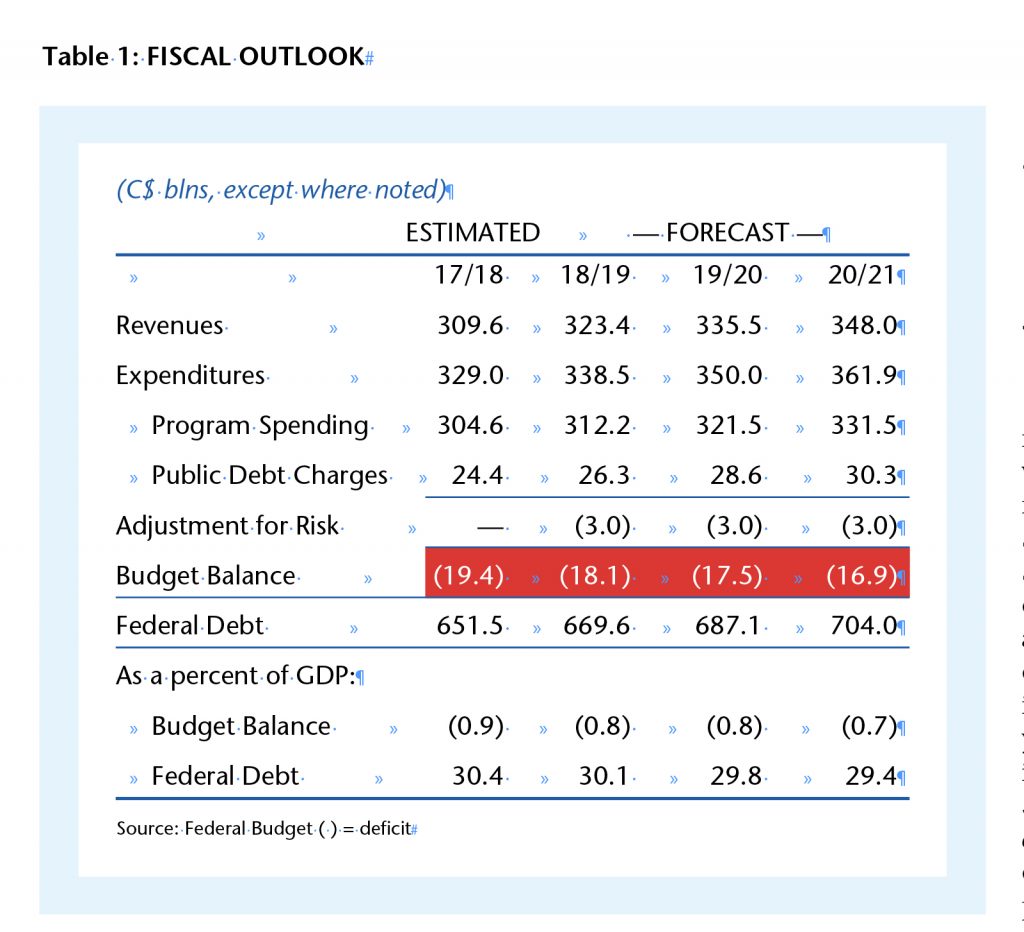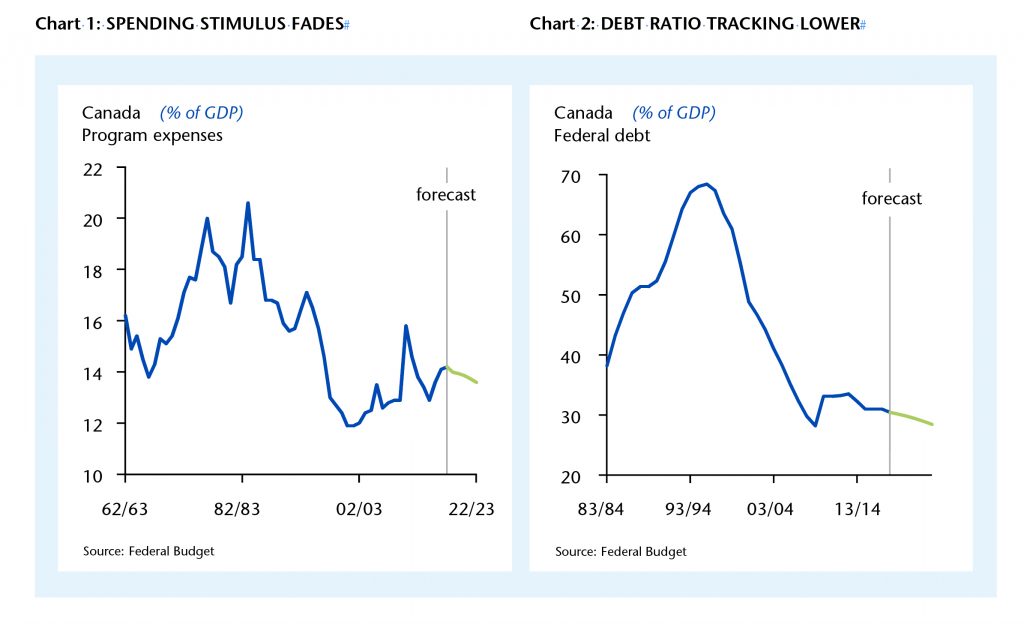Budget 2018: High Times
Douglas Porter and Robert Kavcic
The third budget of the Trudeau government arrived with very little fanfare and subdued expectations, and reinforces Ottawa’s current priorities. Against a backdrop of aggressive U.S. tax reform and NAFTA uncertainty, Finance Minister Bill Morneau played it safe with a largely stand-pat fiscal plan, allowing recent economic strength, deferred infrastructure spending and some tax increases (yes, including a pot tax) to fund yet another spending boost. Ottawa is again projecting a string of double-digit budget deficits as far as the eye can see, narrowing somewhat in the coming fiscal year, while the now-key debt/GDP ratio still gradually drifts lower.
This outlook comes as little surprise, as a fading debt ratio has become the de facto anchor for policy. Last year’s firmer-than-expected economic backdrop has provided a big tailwind for finances, although that favourable trend looks to have largely run its course. Two major areas of uncertainty heading into today were: 1) Would there be any significant response to the competitive challenge from U.S. tax reform; and, 2) Would there be any new spending measures in the year before the next election? The short answers are: No; and, every last dollar subject to keeping the deficit path unchanged.
This is set against what could quite possibly be the high point for economic and fiscal conditions in Canada. Consider what likely lies ahead:
• Economic growth is bound to slow after a powerful upside surprise last year, and as we get deep into an already long cycle;
• Profound uncertainty of the NAFTA talks;
• Debt interest costs are poised to edge higher after years of consistent positive surprises, rising as a share of GDP for the first time in decades;
• There is little fiscal room to stimulate the economy further, assuming the fiscal anchor holds, and short of a major re-profiling of the infrastructure program; and
• U.S. tax reform is a tough new competitive challenge, to which the budget is nearly silent in response.
Meantime, the deficit profile closely follows the update laid out in the 2017 Fall Statement, which is hardly a surprise, given that the current economic outlook is little changed since that point. Recall that update incorporated a much stronger-than-expected 2017 economic growth backdrop into the fiscal plan, reducing average deficits from FY18/19 through FY21/22 by an average of $6.5 billion per year. Similarly, the updated outlook in this budget calls for an $18.1 billion deficit this fiscal year, before shrinking modestly to $13.8 billion by FY21/22—there is still no plan to balance the books within the forecast horizon. Below the surface, some re-profiling of the infrastructure program, lower EI benefit payments (stronger labour market), more favourable Crown expenses and some tax increases have allowed chunky new spending measures to go through without impacting the bottom line.
A contingency of $3 billion per year remains in place through the forecast horizon, offering some wiggle room should the economy slow more than we’ve already seen (potential risks on the trade front, for example). Also, the debt-to-GDP ratio will fade from 30.1 per cent this coming fiscal year, to 28.4 per cent by FY22/23. We’d just reiterate that we are observing some tell-tale late-cycle conditions in North America, often a period that governments should build fiscal capacity—after all, an ostensibly stable debt-to-GDP ratio will deteriorate overnight when the next downturn hits.
The net fiscal impact of new measures detailed in this year’s budget is $5.4 billion (or 0.2 per cent of GDP), fading to average $2.5 billion per year in the subsequent four fiscal years—not big by any stretch, but not immaterial either. Here’s a recap of some of the many new initiatives:
• Program spending will rise 2.5 per cent in FY18/19 after at 6.1 per cent surge in FY17/18. As a share of GDP, program spending will dip slightly to 14 per cent, but that remains up from the recent low of just under 13 per cent in FY14/15. Notably, program spending as a share of GDP will drift very modestly lower over the forecast horizon.

• Infrastructure spending: This budget further re-profiles the infrastructure spending plan, pushing some investment out into future years. Since the Fall Statement, Ottawa has moved more than $2 billion out of FY18/19, with a meaningful chunk landing in FY19/20—an election year.
• EI Parental Sharing Benefit: An additional 5 weeks of parental leave for a family where the second parent agrees to take a minimum of 5 weeks. This will start in June 2019, and is expected to cost roughly $300 million per year, funded through the EI account. As such, EI premiums will rise by 3 cents in FY18/19, to $1.66 (announced earlier). This is one measure aimed at increasing female workforce participation, but likely falls short on that front.
• Other measures to promote gender equality include pay equity legislation in the federal sector and recognition for companies with gender equality on their board.
• Tax loopholes: Various changes to business taxes aim to raise $1.2 billion by FY20/21. This includes taxation of passive income in private corporations, where the business limit (amount of income that triggers a shift to the higher general corporate rate) is reduced from $500,000 as passive investment income increases. In general, a business would need at least $50,000 of investment income to be affected. Other areas targeted include limiting refundable taxes larger companies can obtain on dividend distribution; and a few measures targeting artificial losses generated by financial instruments and share buybacks (measures which the budget suggests will mostly affect banks).
• Pot tax: Ottawa outlines a cannabis tax framework and raises tobacco taxes immediately. Combined, these will raise more than $400 million in FY18/19.
• Canada Workers Benefit: This is a revamped version of the prior Working Income Tax Benefit, made more generous and easier to access. Funding was already accounted for in the Fall Statement.
• Creation of an advisory council to look at a national pharmacare program. This could be the big-ticket item in next year’s budget.
 With a string of deficits still looming, government borrowing requirements will remain elevated, though down somewhat this coming fiscal year. Gross marketable bond issuance will total $115 billion in FY18/19, down from $138 billion in FY17/18. After accounting for maturities, buybacks and other adjustments, the net increase in bonds will be $20 billion in FY18/19, versus $43 billion this year. The government will consider issuing bonds with a maturity of 50 years “subject to favourable market conditions”, as has been the norm recently. The stock of Treasury bills is projected to drift up from $125 billion to $138 billion, while the average term to maturity of domestic market debt is expected to remain stable around 5.5-to-6.5 years. Ottawa continues to focus more of its issuance in the 2-, 3- and 5-year sectors, not at the longer end.
With a string of deficits still looming, government borrowing requirements will remain elevated, though down somewhat this coming fiscal year. Gross marketable bond issuance will total $115 billion in FY18/19, down from $138 billion in FY17/18. After accounting for maturities, buybacks and other adjustments, the net increase in bonds will be $20 billion in FY18/19, versus $43 billion this year. The government will consider issuing bonds with a maturity of 50 years “subject to favourable market conditions”, as has been the norm recently. The stock of Treasury bills is projected to drift up from $125 billion to $138 billion, while the average term to maturity of domestic market debt is expected to remain stable around 5.5-to-6.5 years. Ottawa continues to focus more of its issuance in the 2-, 3- and 5-year sectors, not at the longer end.
Reflecting the above, Ottawa is projecting net new domestic borrowing requirements of $35 billion in the coming fiscal year, with cash balances unchanged. In turn, total federal debt/GDP will fall three ticks, to 30.1% in FY18/19. The debt ratio is projected to eventually grind down to 28.4% by FY22/23—stability (or declines) in this measure is the fiscal anchor for now.
Ottawa’s economic assumptions were brought up-to-date in the Fall Statement, and still serve as reasonable basis for fiscal planning. Canadian real GDP growth is expected to moderate to 2.2 per cent this year, down from the heated 3.0 per cent pace expected in 2017, before cooling further to 1.6 per cent in 2019. Our call is 2.2 per cent this year and 1.8 per cent in 2019. The key message here is that peak growth is well behind the Canadian economy for now, after growing 3.6 per cent in the four quarters through 2017Q2, limiting any potential upside surprises to the bottom line like we saw last year.
Importantly for revenues, nominal GDP growth is expected to taper off as well, to 4.0 per cent this year and 3.5 per cent in 2019 (our calls are 4.2 per cent and 3.9 per cent, respectively). This comes alongside little enthusiasm over oil prices given the supply-demand backdrop—we see WTI averaging $60 by 2019. Three-month interest rates are expected to average 1.4 per cent this year and 2.0 per cent next year, similar to our call of 1.35 per cent and 2.2 per cent, while 10-year GoC yields are expected to rise from 2.3 per cent on average this year to 2.8 per cent next (versus our view of 2.5 per cent and 3.0 per cent). It’s noteworthy that, aside from a brief period through 2013, much of this cycle has been characterized by lower interest rates, leading governments to revise down their debt-service cost estimates in-year. That tide could be turning. All in, and barring an external shock (NAFTA, for example), the risks around the fiscal plan from an economic perspective look relatively balanced.
Douglas Porter is Chief Economist and Robert Kavcic is Senior Economist with BMO Capital Markets.
douglas.porter@bmo.com
robert.kavcic@bmo.com
SaveSave
